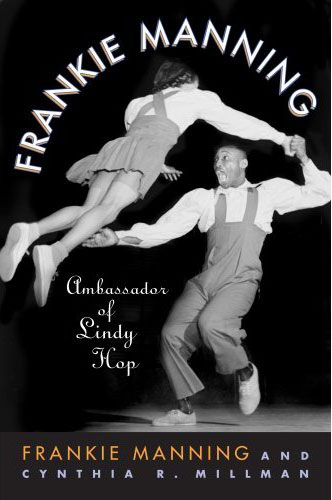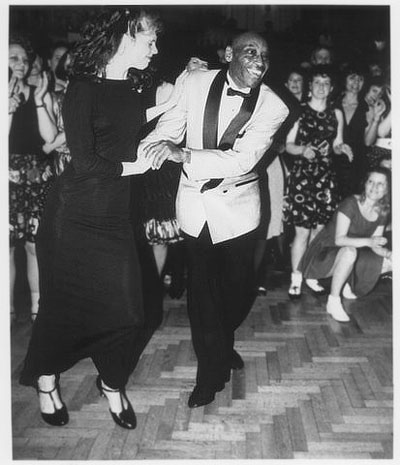 Earlier this year I did a interview series with author Ralph G. Giordano who recently published his book Social Dancing in America: A History and Reference Volume 2 Lindy Hop to Hip Hop, 1901-2000.
Earlier this year I did a interview series with author Ralph G. Giordano who recently published his book Social Dancing in America: A History and Reference Volume 2 Lindy Hop to Hip Hop, 1901-2000.
Here is the interview:
[Part 1: How come you wrote a book about social dancing in America?]
[Part 2: Which dances do you write about in the book? ]
[Part 3: Can you share some interesting facts about Lindy hop?]
[Part 4: Do you include Balboa in the book?]
[Part 5: Tell me about the next book you're writing]
I made a suggestion to the Uppsala City Library to buy both volumes of the book and yesterday they became available. Yey!
There is so much material in these books and I just have read small bits and pieces but it seems to be really good books. What I like about them is that Ralph Giordano describes the social context where the dances were danced. That gives a new perspective to know more about who danced in what kind of places and why they did it.
I have already written about the table of the contents for the second volume and for completeness I'll post the table of the content for the first volume as well. While the second volume might be more directly interesting to readers of this blog, I think you also would be interested in knowing more about the dances that came before swing dances, because they are in a way all connected (at least in a social context).
Table of contents: Volume One “Fair Terpsichore to the Ghost Dance”
Chapter 1: The Minuet, Puritans, and Anti Dance Reformation: 1607 – 1740
Pre-Renaissance:
- Black Hat Dance, Ancient Civilization through 1500 (Tibet)
- Choral Dancing, earliest civilization through 1500
- Ring Around the Rosy, mid-14th century through 20th century (Europe)
- St. Vitus, Middle Ages, (Europe)
- Tarantella, mid-14th century through 20th century (Italy)
- Basses Dansés 14th century to early 16th century (Europe)
o Carole,
o Estampie,
o Farandole,
- Branle, 1400 to 1550 (Europe)
Renaissance:
- Allemande, 16th and 17th century (France)
- Ballo, 1450 to mid-1500s (Italy)
- Courante, mid-1500s through 18th century (Italy and France)
- Fandango, 17th century through 19th century (Spain)
- Galliard, late 16th century to early 17th century (Italian and French)
- Gavotte, 1580 to mid-1700s (France)
- Pavane, 1500 to 1600 (Italy or Spain)
- Sarabande, late 16th century (Spain)
- Volta, mid-1500s (Italy)
17th century to early 18th century:
- Contredanse, 1680 through 19th century (France)
- English Country-Dance, 1650 through 19th century (England)
- Pueblo Circle Dance, 10,000 B.C. through 17th century (North America)
- Maypole, early 1600s through 19th century (England and Ancient Times)
- Minuet, early 1600s through 18th century (France)
Chapter 2 : The Virginia Reel, George Washington, and the Waltz: 1740 – 1820
- American Colonial Minuet, 177o to 1820 (France)
- Big Circle Dances, 1800 through 19th century (England)
- Breakdown, mid- 1700s to early-1800s (African)
- Clog Dancing, early 1700s to 1800s (Scotland, Wales, England, Ireland, and French Canadian)
- Contra Dancing, 1770 through 18th century (France and England)
- Cotillion, 1760 through 19th century (France)
- English Country-Dance, 1650 through 19th century (England)
- Hornpipe, 1700 to 19th century (England, Wales, Scotland, and Ireland)
- Jig, 16th century through 19th century (Ireland and Scotland)
- Quadrille, 1800 through 19th century (England)
- Rigaudon, 1700 to 19th century (France or Italy)
- Square Order Shuffle, 1770s (England)
- Viennese Waltz, 1776 through 19th century (Vienna, Austria)
- Virginia Reel, early 18th century through 19th century (England)
Chapter 3: The Buffalo Dance, Cotillions, and the Polka: 1820 – 1865
- Buffalo Dance, 1800s (Mandan and Sioux)
- Dancing the Slaves, 1607 to 1820
- The Galop dance 1800 through 19th century (Europe)
- Polka, 1844 through 19th century (Czech Republic and Slovakia)
o Mazurka
o Polka Mazurka
o Redowa
o Polka Redowa,
- Ring Shout, (African tribal)
- Schottische, 1844 to 1900 (Bavaria sometimes “Schottisch”)
- Waltz, 1834 through 19th century (German)
o Boston Waltz
o Spanish Waltz (Europe and Mexican Folk)
o Waltz à Deux Temps
o Waltz à Trois Temps
Chapter 4: The Ghost Dance, the Cakewalk, and the Two-Step: 1865 - 1900
- Cakewalk, 1890 to 1905 (African American)
- Cancan, 1890 to 1910 (France)
- The German, 1870 to 1910 (France)
- Ghost Dance, 1870 to 1893 (Native American Indian)
- Square Dance Calling, 1870 through 20th century (American vernacular)
- Two-Step, 1890 to 1910 (American vernacular)
Have you read the books? What do you think of them? Tell me.

 Mr Giordano's next project is as the series editor for a ten-volume series
Mr Giordano's next project is as the series editor for a ten-volume series



